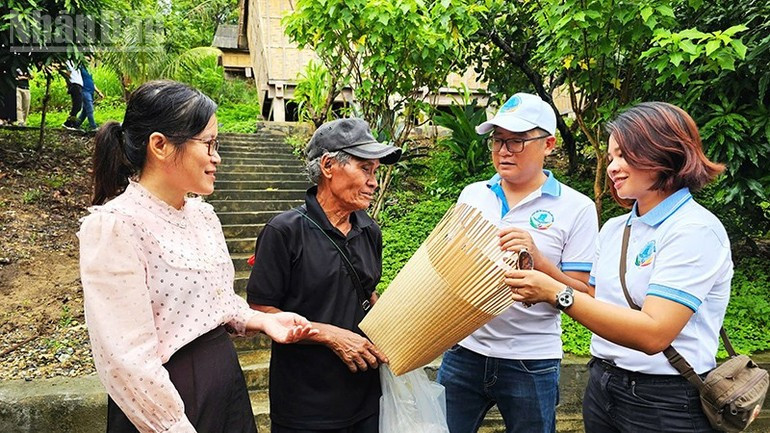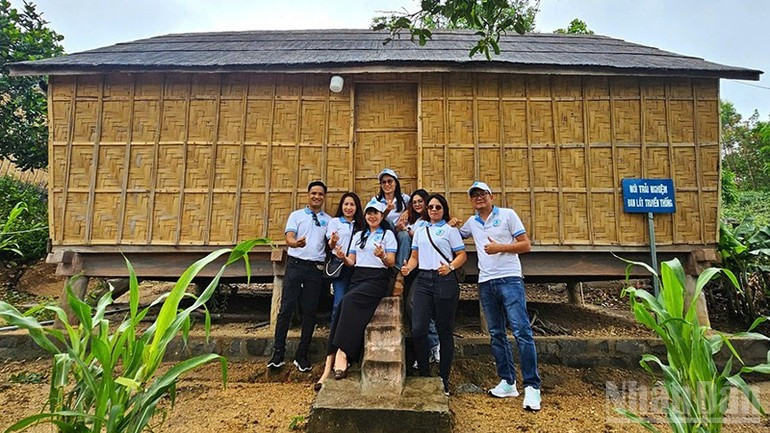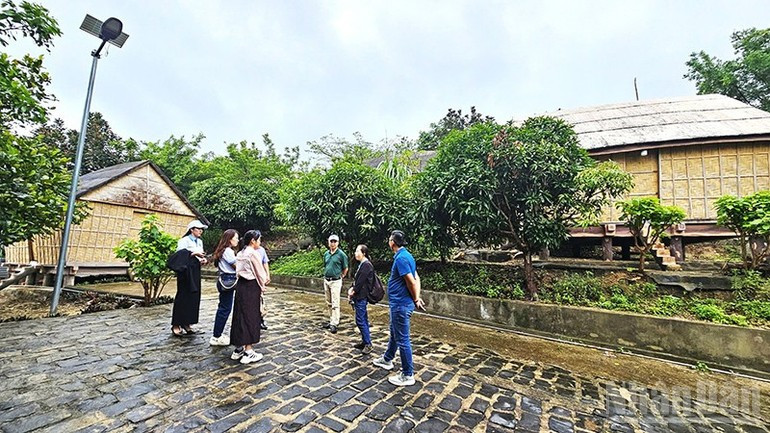From a legendary resistance village during the war against French colonialists, Stor has today evolved into a shining example of cultural and historical tourism, contributing to the building of new-style rural areas while preserving and promoting ethnic identity.
A historical relic and symbol of resistance spirit
Stor Village is closely associated with Hero Nup - an outstanding son of the Ba Na ethnic group and a symbol of the indomitable Central Highlands. It was here, before the August Revolution in 1945, that Nup mobilised and organised the villagers to establish a resistance base against the French.
In extremely harsh and deprived conditions, the local people made use of “forest weapons” such as bamboo spikes, stone traps and bows and arrows to wage guerrilla warfare - defending their land and village, thereby contributing to one of the most remarkable victories on the Central Highlands battlefield.

Village elder Dinh Hmeh introduces traditional Ba Na handicrafts and cultural practices to visitors.
Between September 1950 and February 1951, the French launched ten major campaigns to destroy Stor Village. Yet under the direction of the local Party cell and village head Dinh Nup, the villagers fought back with unyielding determination, turning the area into a “death zone” for the expeditionary troops. These glorious victories carried not only military significance but also profound spiritual value, igniting the flame of resistance among ethnic communities across the Central Highlands.
For its immense contributions to the national liberation cause, Stor was recognised as a model village of the Military Zone and awarded the First-Class Resistance Medal. In 1993, it was officially recognised as a National Historical and Cultural Relic.
Upholding tradition, building a new village in peacetime
Resting not on past glories, Stor Village today is undergoing a strong transformation towards sustainable socio-economic development. In 2017, the village was restored on a hilltop with seven traditional stilt houses, granaries, and the Hero Nup Memorial House, forming an architectural complex rich in Ba Na cultural identity - now a fascinating cultural and historical destination for travellers exploring the Central Highlands.
The village is home to nearly 500 residents from 106 Ba Na households. In addition to farming, villagers actively preserve traditional crafts such as brocade weaving and bamboo weaving to serve tourism
Village elder Dinh Hmeh shared: “We are always delighted to welcome visitors. We treat them like villagers. Whenever a group arrives, everyone in the village gathers to perform xoang dances, cook com lam (bamboo-tube rice), and light the fire in the communal stilt house to greet them warmly.”

Visitors take photos with the restored stilt house in the revolutionary village of Stor.
The restoration of Stor not only aims to preserve a historical relic but also about opens a new path for developing community-based tourism. According to Huynh Thi Tho, Director of Huynh Le Travel Company, after conducting a field survey with the Famtrip delegation of the former Binh Dinh Tourism Association, the company decided to include Stor in its Central Highlands exploration itinerary
“This is a truly special destination with profound cultural and historical value,” Tho said. “We are developing experiential tours connected with the story of Hero Nup, allowing visitors to immerse themselves in the daily life of the Ba Na people and gain a deeper understanding of a heroic chapter in our nation’s history.”
From history to present: Developing tourism in harmony with cultural preservation
Nguyen Thi Kim Chung, Deputy Director of the Gia Lai Provincial Department of Culture, Sports and Tourism, noted: “Recognising Stor’s great potential for cultural and historical tourism, we have invited associations and tourism enterprises to conduct surveys to develop new products following the administrative boundary merger. Stor is one of the key highlights in the province’s sustainable tourism development strategy, closely linked with preserving the traditional cultural values of ethnic minorities.
Accordingly, the province will strengthen training and guidance for villagers in hospitality, homestay services, food preparation and folk performances. It will also promote the image of Stor Village through media channels, fairs, and domestic and international tourism events.

Stor Village restored on a hilltop.
Investment in Stor Village not only preserves heritage values but also contributes to poverty reduction and improvements in both material and spiritual living standards for the Ba Na people. The policy of developing community-based tourism in combination with preserving ethnic identity, responsibly harnessing traditional cultural values, and combining these with economic growth is a key solution for creating sustainable livelihoods, protecting the environment, and enhancing the standing of ethnic communities.
Today, Stor stands not only as a symbol of patriotism but also as evidence of progress, creativity, and resilience. From land once ravaged by war, it has become a “red destination” for heritage tourism and patriotic education for younger generations. Schools, mass organisations, and armed forces across Gia Lai regularly organise field trips to the village, spreading revolutionary history and cultural values throughout the community.
At the same time, the Ba Na cultural identity continues to thrive through traditional festivals such as the new rice celebration and the grave-leaving ceremony, accompanied by graceful xoang dances and the resonant sound of gongs echoing across the mountains. The Space of Gong Culture in the Central Highlands - recognised by UNESCO as an Intangible Cultural Heritage of Humanity - continues to be maintained and passed down among villagers in Stor.
From a courageous resistance village, Stor is now emerging as a model tourism village - a place where tradition meets development. On the nation’s new journey, villages like Stor stand as vivid examples of how heritage preservation can go hand in hand with socio-economic progress, contributing to realising Viet Nam’s aspiration for a strong and prosperous nation.
Song Ngan - Translated by NDO